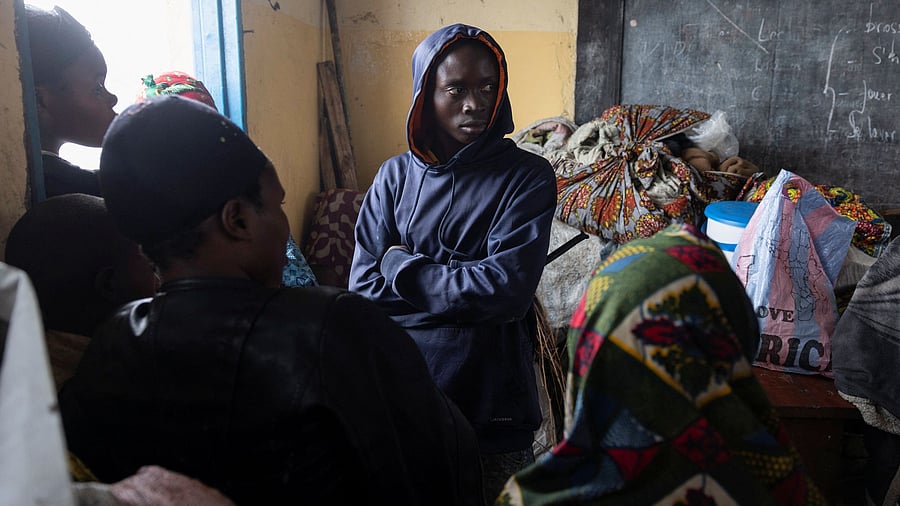
Displaced people wait at a school where they are taking refuge after their camp in Kanyaruchinya was destroyed, after the town of Goma was taken by the M23 rebels, in Kanyaruchinya, Democratic Republic of Congo.
Credit: Reuters Photo
Early last week, M23, a rebel organisation composed of Tutsis, one of the major ethnic groups in the region, seized Goma, the largest city in the Eastern Democratic Republic of Congo (DRC). Allegedly backed by Rwanda, the M23 rebels claim to be protecting Congolese Tutsis from Hutu armed groups responsible for Rwanda’s genocide. The latest reports indicate that M23 insurgents are advancing towards Bukavu, another major city south of Goma.
Since their incursion, large parts of Goma have remained under M23 control, including the airport, border check-posts, and the radio station. The clashes have resulted in over 3,000 deaths, including 20 peacekeepers from South Africa, Malawi, and Tanzania, and at least 2,900 injuries. Additionally, 500,000 civilians have been displaced. Goma residents have voiced their anger at Western embassies for their inaction in restraining the Rwanda-backed M23 insurgents, while Congolese officials have labelled Rwanda’s involvement an act of war.
A Brief History
Since 1996, the DRC has endured two devastating wars involving Rwanda-backed insurgent groups and regional allies. These conflicts led to the downfall of President Mobutu and destabilised successive governments in Kinshasa. Nine different African armies were involved in the wars from 1996 to 2003. Rwanda, supported by Uganda, Burundi, and Angola, initiated the conflict, later drawing in Namibia, Zimbabwe, Eritrea, and Sudan. The Second Congo War became the deadliest conflict since World War II.
More than six million people perished, and another 7.2 million were displaced. If the latest M23 offensive escalates, it could ignite another regional conflict. Meanwhile, the two million residents trapped in Goma’s fighting remain anxious about their fate. The question arises: why do regional countries remain so heavily invested in the DRC conflict, which has already claimed millions of lives?
Roots of Conflict
Three key issues stand out. First, the Congolese state’s inability to tackle threats like M23 and other rebel groups is well known. With numerous armed factions operating with impunity, the Congolese army is overstretched and ineffective. Due to limited capacity, they have resorted to hiring foreign mercenaries, but with little success. Corruption within the military is rampant, as officers focus on profiting from mining operations and laundering military funds rather than strengthening national security. A weak and corrupt military limits the state’s ability to protect its citizens, resources, and eastern borders with Rwanda.
Second, the impact of past wars continues to shape the region’s geopolitics. As Jason Stearns, a leading expert on the DRC, explains, strategic opportunism has driven many actors in the conflict, with mineral extraction becoming a key objective. The DRC is Africa’s largest copper producer, the world’s largest cobalt supplier, and a major source of gold and uranium. Its vast mineral wealth makes it a prime target for illegal mining operations and global resource exploitation.
Third, persistent violence fuels speculation about Rwanda’s alleged involvement in Eastern Congo. Fred Bauma, Executive Director of the Kinshasa-based Ebitoli Institute, asserts that M23’s strength can be largely attributed to Rwandan support. He calls for a firm response from powerful nations like the US, France, and the UK, arguing that international pressure is needed to curtail Rwanda’s influence in the region. Without such intervention, the risk of regional conflict remains high.
Seeking Durable Peace
The UN peacekeeping mission, once a stabilising force in Eastern Congo, has been significantly reduced due to pressure from Kinshasa. It was one of the most extensive and costly UN operations, deploying over 10,000 soldiers and 3,000 civilian personnel at an annual cost exceeding US$1 billion. In December 2023, the UN Security Council (UNSC) voted to withdraw its troops, despite concerns that their departure would increase instability. Fourteen UN bases were dismantled in the first phase, with the remaining forces, including one Indian contingent, expected to leave soon. A dysfunctional UNSC, declining global support for peacekeeping missions, and budget constraints do not bode well for future stability in the region.
In 2022, the East African Community (EAC), of which the DRC is a member, deployed troops under the EAC Regional Force (EACRF). Led by Kenya, this mission aimed to oversee the withdrawal of multiple rebel groups, including M23. However, within months, the DRC government accused the force of colluding with insurgents instead of launching operations against them. In less than a year, the EACRF withdrew, revealing the limitations of regional peacekeeping, conflicting multinational interests, and the challenge of managing host-country expectations.
The Southern African Development Community (SADC) Mission in the Democratic Republic of Congo (SAMIDRC) was deployed in December 2023 to restore peace and security in the region. Troops from Malawi, South Africa, and Tanzania are assisting the Congolese army in combating armed groups. However, after suffering heavy casualties in two weeks of fighting with M23, the mission will need to reassess its strategy.
With global attention focused on other crises, waning international interest in the DRC, apart from its mineral wealth, could encourage further regional power struggles. With major Western nations preoccupied elsewhere, regional powers must make a choice: work towards securing Congo’s future or let it descend further into chaos. The Congolese government and its people must take charge of their own fate, or risk history repeating itself.
(The author commanded the United Nations Multinational Brigade during the first M23 rebellion of 2013 in Eastern Congo)